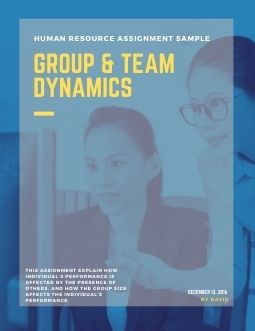Human Resource Assignment Help Samples
You can download the solution to the following question for free.
For further assistance in Human Resource Assignment Help, please check our offerings in Human resource assignment solutions. Our subject-matter-experts provide online assignment help to finance students from across the world and deliver plagiarism free solution with free Turnitin report with every solution.
(AssignmentEssayHelp do not recommend anyone to use this sample as their own work.)
Question
Quote 3 theories for group and team dynamics and 3 theories for experiential learning.
Discuss the theories best with a form of a diagram. One of the experiential learning theory have to be klobs theory and diagram.Word limit is 400 per segment with proper Harvard referencing.
Solution
Group and Team Dynamics theory
In the perspective of group behavior and team dynamics, it is important for us to understand the nature of groups and teams. In organizations, most of the work is done by people working in teams and groups and hence importance of group behavior and dynamics is very important in organization learning. People are attached together through various relationships and variables acts for smooth running of the groups and organizations. This functioning and interrelationships of individuals within/outside the group and amongst the group is known as group dynamics. Group Dynamics discusses on the nature of groups- the variables governing their formation and development, their structure and their inter relationships with individuals, other groups, and the organizations within which they exist (Greenberg & Baron, 2008). Group is a collection of two or more than two individuals maintaining the same stable patterns of relationships, goals and perceiving themselves as part of the group (Forsyth, 2010).
Here in this assignment, I will focus upon theories related with individual's performance in groups. I would be focusing upon to explain how individual's performance is affected by the presence of others, and how the group size affects the individual's performance.
Drive theory of social facilitation – This theory says that, the presence of others increases emotional arousal, which increases the tendency to execute the most prevailing responses (Weiss & Miller, 1971). If these responses are correct they lead towards improved performance otherwise, performance is hindered
Several researches have supported for the advantages of this theory by proposing that people remain concerned, if others judge or evaluate their performance and are present during work. They fear what others will think about them if they did not perform up to the mark.
Social impact theory and Social Loafing
(Latane&Nida (1980) gave the social impact theory based on three rules.
- Social impact results from social forces, number of sources, proximity of event etc.
- Impact increases as the number of sources increases.
- Number of targets is inversely proportional to the impact, i.e. more is the targets less is their impact on individuals.Further, social loafing refers to the phenomenon where group members exert less effort on additional task if the size increases. This phenomenon is explained by social impact theory. Researchers suggest that, social loafing is culture driven, i.e. it is not a universal phenomenon but is exhibition of cultural values.
The Tuckman Theory
Tuckman (1965) presented four-stage model for team development; the stages in this model are dependence, conflict, cohesion and functional roles. Tuckman's model is also known as FSNP (Forming, Storming, Norming and Performing) and is extensively used in organizational context. The author also proses that a good fit between observed stages and the proposed model exists.
Though the model fits well and is conceptually sound but lacks in empirical validation. Ingram et al (1997) states that despite the importance of research in team building much of the literature is inconclusive and is anecdotal.
Experiential learning theory (ELT)
Most researchers have toiled in the area of knowledge procurement and proposed that direct experience is the most vital part in knowledge creation. ELT is most widely used theory in the domain of management learning research. ELT was given by Kolb (1984) defining learning as, 'the route whereby knowledge is formed through the alteration of familiarity. Knowledge results from the combination of acquisitiveness and altering experience.
- Klob's experiential learning Model-
In the year 1984, David A. Kolb, given the most acknowledged model on experiential learning advocating experience as the most important factor in learning.
There are following four stages.
- Concrete experience – Refers to the stage of direct involvement, i.e. one can't learn until he/she doesn't have involved in the job directly. According to Kolb (1984), one can't learn only by watching or reading only.
- Reflective observation- learning by reviewing and stepping back.
- Abstract Conceptualization- Evaluating, interpreting and drawing conclusions from the work done in the past and thus enhancing knowledge via presenting models, giving theories or facts.
Source: http://www2.le.ac.uk/departments/gradschool/training/resources/teaching/theories/kolb
- Praxis as an experiential learning model-
Burnard (1989) states that, action and reflection are the two important sources of experiential learning. The term Praxis is originated from Karl Marx work in the 1840's and Paulo Freire.
- Science Education and the Learning Cycle –
Prof. Robert Karplus gave the learning cycle theory in the year 1967 and is accepted for science education. He gave three phases of experiential learning that time and is now described by Lawson et al (1989) as learning cycle model. In this model three phases- Term introduction, exploration and concept application are performed in stages. Several studies have supported for this theory when used in science education (Bredderman, 1983; Cohen, 1992; Hartshorn& Nelson, 1990; Shymansky, Kyle, &Alport, 1983)




 WhatsApp Us
WhatsApp Us